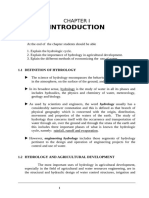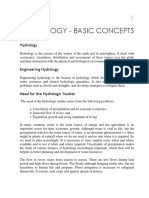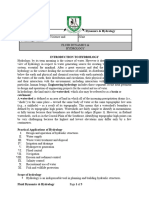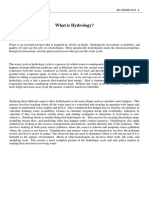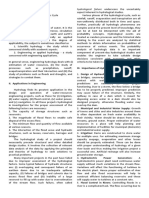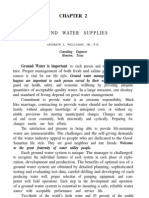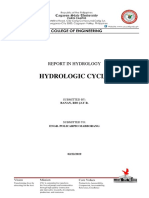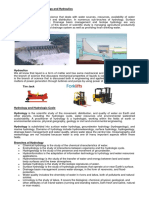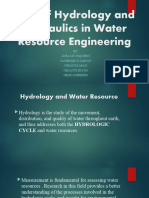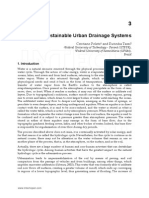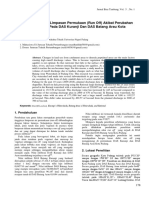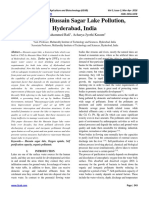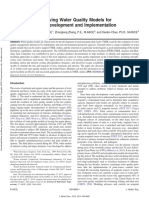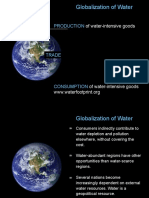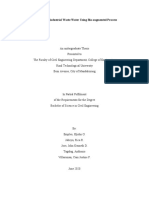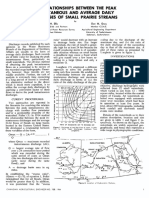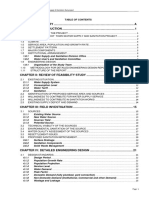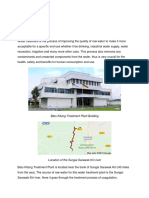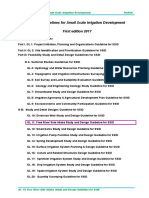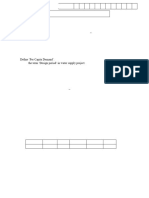Atme College of Engineering, Mysuru
Atme College of Engineering, Mysuru
Uploaded by
Praveen KumarCopyright:
Available Formats
Atme College of Engineering, Mysuru
Atme College of Engineering, Mysuru
Uploaded by
Praveen KumarOriginal Description:
Original Title
Copyright
Available Formats
Share this document
Did you find this document useful?
Is this content inappropriate?
Copyright:
Available Formats
Atme College of Engineering, Mysuru
Atme College of Engineering, Mysuru
Uploaded by
Praveen KumarCopyright:
Available Formats
HYDROLOGY AND IRRIGATION ENGINEERING (15CV73)
MODULE 1
1. INTRODUCTION
1.1 HYDROLOGY
1.2 SCOPE OF HYDROLOGY
1.3 IMPORTANCE OF HYDROLOGY
1.4 HYDROLOGIC CYCLE (HORTON’S)
1.5 WATER BUDGET EQUATION
1.6 PRECIPITATION
1.7 DEFINITIONS
1.8 FORMS OF PRECIPITATION
1.9 FORMATION OF PRECIPITATION
1.10 TYPES OF PRECIPITATION
1.11 MEASUREMENT OF RAIN FALL
1.11.1 NON RECORDING RAINGAUGE
1.11.2 RECORDING RAIN GAUGES
1.12 COMPUTATION OF MEAN RAINFALL
1.13 ESTIMATION OF MISSING DATA
VTUPulse.com
1.14 RAINGAUGE DENSITY
1.15 OPTIMUM NUMBER OF RAIN GAUGE STATIONS
1.16 CONSISTENCY OF RAINFALL DATA (DOUBLE MASS CURVE METHOD)
1.17 PRESENTATION OF PRECIPITATION DATA
ATME COLLEGE OF ENGINEERING, MYSURU Page 1
HYDROLOGY AND IRRIGATION ENGINEERING (15CV73)
1. INTRODUCTION
The world‘s total water resources are estimated to be around 1.36X 1014 ha-m. 92.7% of this
water is salty and is stored in oceans and seas. Only 2.8% of total available water is fresh
water. Out of this 2.8% fresh water, 2.2% is available as surface water and 0.6% as ground
water. Out Of the 2.2% surface water, 2.15% is stored in glaciers and ice caps, 0.01% in lakes
and streams and the rest is in circulation among the different components of the Earth‘s
atmosphere.
Out of the 0.6% ground water only about 0.25% can be economically extracted. It can be
summarized that less than 0.26% of fresh water is available for use by humans and hence
water has become a very important resource. Water is never stagnant (except in deep
aquifers), it moves from one component to other component of the earth through various
process of precipitation, run off, infiltration, evaporation etc. For a civil engineer, it is
important to know the occurrence, flow, distribution etc. it important to design and construct
many structures in contact with water.
1.1 HYDROLOGY
Hydrology may be defined as applied science concerned with water of the Earth in all its
VTUPulse.com
states, their occurrences, distribution and circulation through the unending hydrologic cycle
of precipitation, consequent runoff, stream flow, infiltration and storage, eventual evaporation
and re-precipitation. Hydrology is a highly inter-disciplinary science. It draws many
principles from other branches of science like:-
Meteorology and Climatology
Physical Geography
Agronomy and Forestry
Geology and Soil science
Oceanography
Hydraulics
Probability and Statistics
Ecology
Hydrology concerns itself with three forms of water:-
Above land as atmospheric water or precipitation.
On land or surface as stored water or runoff
Below the land surface as ground water or percolation
ATME COLLEGE OF ENGINEERING, MYSURU Page 2
HYDROLOGY AND IRRIGATION ENGINEERING (15CV73)
1.2 SCOPE OF HYDROLOGY
The study of hydrology helps us to know:
1. The maximum probable flood that may occur at given sit and its frequency; this is
required for the safe design of drains, bridges & culverts, dams & reservoirs, channels
and other flood control system.
2. The water yield from a basin –its occurrence, quantity and frequency etc; this is necessary
for the design of dams, municipal water supply, water power, river navigation etc.
3. The ground water development for which a knowledge of Hydro geology of the area i.e.
formation of the soils, recharge facilities like streams and reservoirs, rainfall pattern,
climate; cropping pattern etc are required.
4. The maximum intensity of storm & its frequency for the design of drainage project in the
area.
1.3 IMPORTANCE OF HYDROLOGY
Design of Hydraulic Structures: Structures such as bridges, causeways, dams, spillways
etc. are in contact with water. Accurate hydrological predictions are necessary for their
proper functioning. Due to a storm, the flow below a bridge has to be properly predicted.
VTUPulse.com
Improper prediction may cause failure of the structure. Similarly the spillway in case of a
dam which is meant for disposing excess water in a dam should also be designed properly
otherwise flooding water may overtop the dam.
Municipal and Industrial Water supply: Growth of towns and cities and also industries
around them is often dependent on fresh water availability in their vicinity. Water should
be drawn from rivers, streams, ground water. Proper estimation of water resources in a
place will help planning and implementation of facilities for municipal (domestic) and
industrial water supply.
Irrigation: Dams are constructed to store water for multiple uses. For estimating
maximum storage capacity seepage, evaporation and other losses should be properly
estimated. These can be done with proper understanding of hydrology of a given river
basin and thus making the irrigation project a successful one. Artificial recharge will also
increase ground water storage. It has been estimated that ground water potential of
gangetic basin is 40 times more than its surface flow.
ATME COLLEGE OF ENGINEERING, MYSURU Page 3
HYDROLOGY AND IRRIGATION ENGINEERING (15CV73)
Hydroelectric Power Generation: A hydroelectric power plant need continuous water
supply without much variations in the stream flow. Variations will affect the functioning
of turbines in the electric plant. Hence proper estimation of river flow and also flood
occurrences will help to construct efficient balancing reservoirs and these will supply
water to turbines at a constant rate.
Flood control in rivers: Controlling floods in a river is a complicated task. The flow
occurring due to a storm can be predicted if the catchment characteristics are properly
known. In many cases damages due to floods are high. Joint work of hydrologist and
meteorologists in threatening areas may reduce damage due to floods. Flood plain zones
maybe demarked to avoid losses.
Navigation: Big canals in an irrigation scheme can be used for inland navigation. The
depth of water should be maintained at a constant level. This can be achieved by lock
gates provided and proper draft to be maintained. If the river water contains sediments,
they will settle in the channel and cause problems for navigation. Hence the catchment
characteristics should be considered and sediment entry into the canals should be done.
Erosion & sediment control: Excessive erosion in the catchment feeds the sediment into
VTUPulse.com
the runoff. The reservoir may lose their capacity at a faster rate reducing their economic
span drastically. Tones of fertile top soil will be lost every year resulting in crop yields.
Hydrology of the catchment along with the knowledge of the existing water shed
management practices will help in finding out the effective erosion. These measures
includes the fixing crop pattern & cropping procedures, formation of contour bunds,
aforestation etc. effective erosion control measures not only decreases the sediment load
in the stream but also reduces peak flood discharges because of increased infiltration
opportunities in the catchment.
Pollution control: It is an easy way to dispose sewage generated in a city or town into
streams and rivers. If large stream flow is available compared to the sewage discharge,
pollution problems do not arise as sewage gets diluted and flowing water also has self-
purifying capacity. The problem arises when each of the flows are not properly estimated.
In case sewage flow is high it should be treated before disposal into a river or stream.
ATME COLLEGE OF ENGINEERING, MYSURU Page 4
HYDROLOGY AND IRRIGATION ENGINEERING (15CV73)
1.4 HYDROLOGICAL CYCLE
Water exists on the earth in gaseous form (water vapor), liquid and solid (ice) forms and is
circulated among the different components of the Earth mainly by solar energy and planetary
forces. Sunlight evaporates sea water and this evaporated form is kept in circulation by
gravitational forces of Earth and wind action. The different paths through which water in
nature circulates and is transformed is called hydrological cycle. Hydrological cycle is
defined as the circulation of water from the sea to the land through the atmosphere back to
the sea often with delays through process like precipitation, interception, runoff, infiltration,
percolation, ground water storage, evaporation and transpiration also water that returns to the
atmosphere without reaching the sea.
VTUPulse.com
FIG 1: Descriptive representation of hydrological cycle
The hydrological cycle has 3 important phases:
1. Evaporation & Evapotranspiratrion
2. Precipitation
3. Run off
Evaporation takes place from the surface of ponds, lakes, reservoirs and ocean surfaces.
Transpiration takes place from surface vegetation i.e. from plant leaves of cropped land forest
ATME COLLEGE OF ENGINEERING, MYSURU Page 5
HYDROLOGY AND IRRIGATION ENGINEERING (15CV73)
etc. These vapours rise to sky and are condensed at higher altitude and form the clouds. The
clouds melt and sometime burst resulting in precipitation of different forms like rain, snow,
hail, mist and frosts. A part of this precipitation flows over the land as runoff and a part
infiltrate into the soil which build up ground water table. The surface run-off joins the stream
and thus water stored in the reservoir. A portion of the surface runoff and ground water flows
back to ocean. Again evaporation starts from surfaces of lakes, reservoirs and ocean & thus
the cycle repeats.
The hydrological cycle can also be represented in many different ways in diagrammatic
forms as
1. Horton‘s Qualitative representation
2. Horton‘s Engineering representation
VTUPulse.com
FIG 1.2: Qualitative representation of Horton‘s hydrological Cycle
ATME COLLEGE OF ENGINEERING, MYSURU Page 6
HYDROLOGY AND IRRIGATION ENGINEERING (15CV73)
VTUPulse.com
FIG 1.3: Engineering representation of Horton‘s hydrological Cycle
1.5 WATER BUDGET EQUATION FOR A CATCHMENT
The area of land draining into a stream at a given location is known as catchment area or
drainage area or drainage basin or water shed.
ATME COLLEGE OF ENGINEERING, MYSURU Page 7
HYDROLOGY AND IRRIGATION ENGINEERING (15CV73)
For a given catchment area in any interval of time, the continuity equation for water balance
is given as: (Change in mass storage) = (mass in flow) - (mass outflow)
Δs = Vi - Vo
The water budget equation for a catchment considering all process for a time interval Δt is
written as: Δs = P- R-G-E-T
Where, Δs represent change in storage
P- Precipitation, G- Net ground water flowing outside the catchment, R- Surface runoff
E- Evaporation, T- Transpiration
Storage of water in a catchment occurs in 3 different forms and it can be written as:
S= Ss +Sm +Sg
Where, S- storage, Ss - Surface water storage, Sm - soil moisture storage,
Sg - ground water storage
Hence change in storage maybe expressed as:
ΔS = ΔSs + ΔSm + ΔSg
The rainfall runoff relationship can be written as: R= P - L
R- Surface runoff, P- Precipitation, L- Losses
i.e. water not available to runoff due to infiltration, evaporation, transpiration and surface
VTUPulse.com
storage.
1.6 PRECIPITATION
It is defined as the return of atmospheric moisture to the ground in the form of solids or
liquids. Precipitation is the fall of water in various forms on the earth from the cloud. The
usual form of precipitation is rain and snow. In India snowfall occurs only in Himalayan
region during water. Most of the precipitation occur in India is the form of rain.
The following are the main characteristics of rainfall:
a. Amount or quantity: The amount of rainfall is usually given as a depth over a specified
area, assuming that all the rainfall accumulates over the surface and the unit for measuring
amount of rainfall is cm. The volume of rainfall = Area x Depth of Rainfall (m3)
The amount of rainfall occurring is measured with the help of rain gauges.
b. Intensity: This is usually average of rainfall rate of rainfall during the special periods of a
storm and is usually expressed as cm/ hour.
c. Duration of Storm: In the case of a complex storm, we can divide it into a series of storms
of different durations, during which the intensity is more or less uniform.
ATME COLLEGE OF ENGINEERING, MYSURU Page 8
HYDROLOGY AND IRRIGATION ENGINEERING (15CV73)
d. Aerial distribution: During a storm, the rainfall intensity or depth etc. will not be uniform
over the entire area. Hence we must consider the variation over the area i.e. the aerial
distribution of rainfall over which rainfall is uniform.
1.7 DEFINITIONS
Infiltration: Infiltration is the passage of water across the soil surface. The vertical
downward movement of water within the soil is known as percolation. The infiltration
capacity is the maximum rate of infiltration for the given condition of the soil. Obviously the
infiltration capacity decreases with time during/ after a storm.
Overland Flow: This is the part of precipitation which is flowing over the ground surface
and is yet to reach a well-defined stream.
Surface runoff: When the overland flow enters a well-defined stream it is known as surface
runoff (SRO).
Interflow for Sub surface flow: A part of the precipitation which has in-filtered the ground
surface may flow within the soil but close to the surface. This is known as interflow. When
the interflow enters a well-defined stream, then and only it is called run off.
VTUPulse.com
Ground water flow: This is the flow of water in the soil occurring below the ground water
table. The ground water table is at the top level of the saturated zone within the soil and it is
at atmospheric pressure. Hence it is also called phreatic surface. A portion of water may enter
a well-defined stream. Only then it is known as runoff or base flow. Hence we say that runoff
is the portion of precipitation which enters a well-defined stream and has three components;
namely- surface runoff, interflow runoff and ground water runoff or base flow.
Evaporation: This is the process by which state of substance (water) is changed from liquid
state to vapor form. Evaporation occurs constantly from water bodies, soil surface and even
from vegetation. In short evaporation occurs when water is exposed to atmosphere (during
sunlight). The rate of evaporation depends on the temperature and humidity.
Transpiration: This is the process by which the water extracted by the roots of the plants is
lost to the atmosphere through the surface of leaves and branches by evaporation. Hence it is
also known as evapotranspiration.
ATME COLLEGE OF ENGINEERING, MYSURU Page 9
HYDROLOGY AND IRRIGATION ENGINEERING (15CV73)
1.8 FORMS OF PRECIPITATION
1. Drizzle – This is a form of precipitation consisting of water droplets of diameter less than
0.05 cm with intensity less than 0.01cm/ hour. In this drops are so small that they appear
to flow in the air.
2. Rainfall – This is a form of precipitation of water drops larger than 0.05cm diameter up to
0.6cm diameter. Water drops of size greater than 0.6 cm diameter tend to break up as they
fall through the atmosphere. Intensity varies from 0.25 cm/ hour to 0.75cm/ hour.
Light Rain – Traced to 0.25cm/hr
Moderate rain – 0.25cm/hr to 0.75cm/hr
Heavy rain – greater than 0.75cm/hr
3. Snow – This is precipitation in the form of ice crystals. These crystals usually carry a thin
coating of liquid water and form large flakes when they collide with each other.
4. Hail – The precipitation in the form of balls are irregular of ice of diameter 5mm or more
is called Hail.
5. Glaze (Freezing Rain) – This is the ice coating formed when a drizzle or rainfall comes in
contact with very old objects on the ground. It occurs when there is cold layer of air with
temperature below 00C
VTUPulse.com
6. Sleet – Sleet is the precipitation in the form of melting snow. It is a mixture of snow and
rain. It is in the form of pellet of diameter 1mm-4mm. Sleet is also known as small hail.
7. Frost – Frost is a form of precipitation which occurs in the form of scales, needles,
feathers or fans.
8. Dew – Dew is a form of precipitation which doesn’t occur because of condensation in
higher layer of atmosphere but it is formed by condensation directly on the ground. Dew
occurs in the night when the ground surface is cooled by outgoing radiation.
1.9 FORMATION OF PRECIPITATION
Precipitation occurs when the following four conditions are satisfied:
Cooling of air masses
Formation of clouds into ice crystals due to condensation
Growth of water droplets
Accumulation of moisture
ATME COLLEGE OF ENGINEERING, MYSURU Page 10
HYDROLOGY AND IRRIGATION ENGINEERING (15CV73)
Cooling of air masses
Cooling occurs when air ascents from earth surface to upper level in the atmosphere. The
decrease in temperature of undisturbed atmospheric air with an increase in altitude is called
lapse rate (6.50C/km). The precipitation depends on the lapse rate and amount of cooling.
Formation of clouds due to condensation
Condensation occurs when the water vapour in the atmosphere is converted into liquid
droplet or into ice crystals when temperature is quiet low. Clouds are formed due to
condensation. The water vapour converted into water droplets due to the presence of small
solid particles called condensation nuclei or Hydroscopic nuclei of sizes 0.001 micron to 10
micron. The rate of condensation increases as the number of nuclei increases.
Growth of water droplets
The size of water droplets in a cloud is usually very small of about 0.02mm. However this
cannot reach the ground unless there is growth in water droplet. This can be achieved by
means of coalescence. Coalescence of droplets occurs to form larger drops and is due to
difference of velocity of larger droplets and smaller droplets and due to co-existence of ice
VTUPulse.com
crystals and water droplets in clouds.
Accumulation of moisture
The air must contain sufficient amount of moisture so that appreciable precipitation can occur
after meeting the evaporation loses between the clouds and ground. Accumulation of
moisture in atmosphere occurs due to evaporation of lands, vegetation and water surfaces.
1.10 TYPES OF PRECIPITATION
One of the essential requirements for precipitation to occur is the cooling of large masses of
moist air. Lifting of air masses to higher altitudes is the only large scale process of cooling.
Hence the types of precipitation based on the mechanism which causes lifting of air masses
are as follows:
1. Convective precipitation: This is due to the lifting of warm air which is lighter than the
surroundings. Generally this type of precipitation occurs in the tropics where on a hot
day, the ground surface gets heated unequally causing the warmer air to lift up and
precipitation occurs in the form of high intensity and short duration. This usually occurs
in the form of a local whirling thunder storm and for very short duration, it is called
ATME COLLEGE OF ENGINEERING, MYSURU Page 11
HYDROLOGY AND IRRIGATION ENGINEERING (15CV73)
‘tornado’, when accompanied by very high velocity destructive winds. Convective
precipitation covers small area and rainfall intensity may be very high (10cm/hr).
2. Orographic Precipitation: It is the most important precipitation and is responsible for most
of heavy rains in India. Orographic precipitation is caused by air masses which strike
some natural topographic barriers like mountains and cannot move forward and hence the
rising amount of precipitation. The greatest amount of precipitation falls on the windward
side and leeward side has very little precipitation.
Ex: Cherrapunji, Agumbe in Western Ghats of southern India gets heavy Orographic
precipitation.
VTUPulse.com
3. Cyclonic Precipitation: This is the precipitation associated with cyclones or moving
masses of air and involves the presence of low pressures. A cyclone is a large zone of low
pressure which is surrounded by a circular wind motion. This type of precipitation occur
dye to pressure differences created by the unequal heating of earth’s surface. Air tends to
move into low pressure zone from surrounding areas and displaces low pressure air
upwards. The wind blows spirally inward counter clockwise in the northern hemisphere
and clockwise in the southern hemisphere.
This is further sub divided into 2 categories
a. Non Frontal cyclonic precipitation: In this, a low pressure area develops. (Low-pressure
area is a region where the atmospheric pressure is lower than that of surrounding
locations). The air from surroundings converges laterally towards the low pressure area.
This results in lifting of air and hence cooling. It may result in precipitation.
ATME COLLEGE OF ENGINEERING, MYSURU Page 12
HYDROLOGY AND IRRIGATION ENGINEERING (15CV73)
b. Frontal cyclonic precipitation: FRONT is a barrier region between two air masses having
different temperature, densities, moisture, content etc. If a warm and moist air mass
moves upwards over a mass of cold and heavier air mass, the warm air gets lifted, cooled
and may result in precipitation. Such a precipitation is known as warm front precipitation.
FIG: Cyclonic precipitation
VTUPulse.com
4. Turbulent Precipitation: This precipitation is usually due to a combination of the several
of the above cooling mechanisms. The change in frictional resistance as warm and moist
air moves from the ocean onto the land surface may cause lifting of air masses and hence
precipitation due to cooling. This precipitation results in heavy rainfall. The winter
rainfall in Tamilnadu is mainly due to this type of turbulent ascent.
1.11 MEASUREMENT OF RAINFALL
Rainfall is measured on the basis of the vertical depth of water accumulated on a level surface
during an interval of time, if all the rainfall remained where it fell. It is measured in mm‘. The
instrument used for measurement of rainfall is called “Rain gauge”. These are classified as:
Non recording type Raingauge
Recording type Raingauge
1.11.1 Non recording type Raingauges
These rain gauges which do not record the depth of rainfall, but only collect rainfall. Symon‘s
rain gauge is the usual non recording type of rain gauge. It gives the total rainfall that has
ATME COLLEGE OF ENGINEERING, MYSURU Page 13
HYDROLOGY AND IRRIGATION ENGINEERING (15CV73)
occurred at a particular period. It essentially consists of a circular collecting area 127 mm in
diameter connected to a funnel. The funnel discharges the rainfall into a receiving vessel. The
funnel and the receiving vessel are housed in a metallic container. The components of this
rain gauge are a shown in fig below.
FIG 1.4: Symons Raingauge
VTUPulse.com
The water collected in the receiving bottle is measured by a graduated measuring jar with an
accuracy of 0.1 ml. the rainfall is measured every day at 8:30 am IST and hence this
Raingauge gives only depth of rainfall for previous 24 hours. During heavy rains,
measurement is done 3 to 4 times a day.
Thus Symons Raingauge gives only the total depth of rainfall for previous 24 hours and
doesn’t provide intensity and rainfall duration of the rainfall during different time interval of
the day.
1.11.2 Recording type Raingauges
These are rain gauges which can give a permanent, automatic rainfall record (without any
bottle recording) in the form of a pen mounted on a clock driven chart. From the chart
intensity or rate of rainfall in cm per hour or 6 hrs, 12 hrs…... besides the total amount of
rainfall can be obtained.
Advantages of recording rain gauges:
1. Necessity of an attendant does not arise
2. Intensity of rainfall at anytime as well as total rainfall is obtained, where as non recording
gauge gives only total rainfall.
ATME COLLEGE OF ENGINEERING, MYSURU Page 14
HYDROLOGY AND IRRIGATION ENGINEERING (15CV73)
3. Data from in accessible places (hilly regions) can be continuously obtained.
4. Human errors are eliminated.
5. Capacity of gauges is large.
6. Time intervals are also recorded.
Disadvantages of recording rain gauges:
1. High initial investment cost.
2. Recording is not reliable when faults in gauge arise (mechanical or electrical) till faults are
corrected.
1.11.2.1 TYPES OF RECORDING RAINGAUGE
1. Tipping bucket rain gauge:
This is the most common type of automatic rain gauge adopted by U S Meteorological
Department.
VTUPulse.com
FIG 1.5: Tipping Bucket Raingauge
This consists of receiver draining into a funnel of 30 cm diameter. The catch (rainfall) from
funnel falls into one of the pair of small buckets (tipping buckets). These buckets are so
balanced that when 0.25 mm of rainfall collects in one bucket, it tips and brings the other
bucket into position.
Tipping of bucket completes an electric circuit causing the movement of pen to mark on
clock driven receiving drum which carries a recorded sheet. These electric pulses generated
are recorded at the control room far away from the rain gauge station. This instrument is
further suited for digitalizing the output signal.
ATME COLLEGE OF ENGINEERING, MYSURU Page 15
HYDROLOGY AND IRRIGATION ENGINEERING (15CV73)
The tipping bucket Raingauge is quiet durable, simple to operate and convenient but it has
following disadvantage:
It doesn’t give accurate result in case of intense rainfall, because some of rain which falls
during the tipping of bucket is not measured.
Because of discontinuous nature of the record, the instrument is not satisfactory for using
light drizzle or very light rain.
The time of beginning and ending of rainfall cannot be determined accurately.
This gauge is not suitable for measuring snow without heating the collector.
2. Weighing bucket rain gauge:
This is the most common type of recording or automatic rain gauge adopted by Indian
Meteorological Department. The construction of this rain gauge is shown in figure below.
VTUPulse.com
FIG 1.6: Weighing Bucket Raingauge
It consists of a receiving bucket supported by a spring or lever. The receiving bucket is
pushed down due to the increase in weight (due to accumulating rain fall). The pen attached
to the arm continuously records the weight on a clock driven chart. The chart obtained from
this rain gauge is a mass curve of rain fall.
ATME COLLEGE OF ENGINEERING, MYSURU Page 16
HYDROLOGY AND IRRIGATION ENGINEERING (15CV73)
From the mass curve the average intensity of rainfall (cm/hr) can be obtained by calculating
the slope of the curve at any instant of time. The patterns as well as total depth of rain fall at
different instants can also be obtained.
The advantages of this raingauge are that it can record snow, hail and mixture of rain and
snow.
The disadvantages are:
The effect of temperature and friction on weighing mechanism may introduce error.
Failure of reverse mechanism results in loss of record.
Because of wind action on bucket, erotic traces may be recorded on the chart.
VTUPulse.com
3. Siphon or float type rain gauge
This is also called integrating rain gauge as it depicts an integrated graph of rain fall with
respect to time. The construction of this rain gauge is shown in figure below.
FIG 1.7: SIPHON RAINGAUGE
ATME COLLEGE OF ENGINEERING, MYSURU Page 17
HYDROLOGY AND IRRIGATION ENGINEERING (15CV73)
A receiver and funnel arrangement drain the rainfall into a container, in which a float
mechanism at the bottom is provided. As water accumulates, the float rises. A pen arm
attached to the float mechanism continuously records the rainfall on a clock driven chart and
also produces a mass curve of rain fall. When the water level rises above the crest of the
siphon, the accumulated water in the container will be drained off by siphonic action. The
rain gauge is ready to receive the new rainfall.
4. Radar measurement of rainfall
The principle involves RADAR as shown in figure below. Electromagnetic waves known as
pulses are produced by a transmitter and are radiated by a narrow beam antenna. The
reflections of these waves from the targets (echoes) are again intercepted by the same
antenna. A receiver detects these echoes, amplifies and transforms them into video form on
an indicator called Plan Position indicator. The screen of indicator is illuminated dimly where
there is no target (rainfall) and a bright spot occurs where there is a target and a bright patch
where there is an extended object such as rain shower.
VTUPulse.com
ATME COLLEGE OF ENGINEERING, MYSURU Page 18
HYDROLOGY AND IRRIGATION ENGINEERING (15CV73)
FACTORS GOVERNING SELECTION OF SITE FOR RAIN GAUGE STATIONS:
The site for rain gauge station should be an open space without the presence of trees or
any covering.
The rain gauge should be properly secured by fencing.
The site for rain gauge station should be a true representation of the area which is
supposed to give rainfall data.
The distance of any object or fence from the rain gauge should not be less than twice the
height of the object or fence and in no case less than 30 m.
The rain gauge should not be set upon the peak or sides of a hill, but on a nearby fairly
level ground.
The rain gauge should be protected from high winds.
The rain gauge should be easily accessible to the observers at all times.
1.12 DETERMINATION OF AVERAGE PRECIPITATION OVER AN AREA
The rainfall measured by a rain gauge is called point precipitation because it represents the
rainfall pattern over a small area surrounding the rain gauge station. However in nature rain
fall pattern varies widely. The average precipitation over an area can be obtained only if
VTUPulse.com
several rain gauges are evenly distributed over the area. But there is always limitation to
establish several rain gauges. However this draw back can be overcome by adopting certain
methods as mentioned below, which give fair results.
Arithmetic mean method: In this method to determine the average precipitation over an
area the rainfall data of all available stations are added and divided by the number of stations
to give an arithmetic mean for the area. That is if P1, P2 and P3 are the precipitations
recorded at three stations A, B and C respectively, then average precipitation over the area
covered by the rain gauges is given by
Pav = P1+P2+P3/3
This method can be used if the area is reasonably flat and individual gauge readings do not
deviate from the mean (average). This method does not consider aerial variation of rainfall,
non-even distribution of gauges, Orographic influences (presence of hills), etc. This method
can also be used to determine the missing rain fall reading from any station also in the given
area.
ATME COLLEGE OF ENGINEERING, MYSURU Page 19
HYDROLOGY AND IRRIGATION ENGINEERING (15CV73)
Thiessen Polygon method: This is also known as weighted mean method. This method is
very accurate for catchments having areas from 500 to 5000 km2. In this method rainfall
recorded at each station is given a weight age on the basis of the area enclosing the area. The
procedure adopted is as follows.
The rain gauge station positions are marked on the catchment plan.
Each of these station positions are joined by straight lines.
Perpendicular bisectors to the previous lines are drawn and extended up to the boundary
of the catchment to form a polygon around each station.
Using a planimeter, the area enclosed by each polygon is measured.
The average precipitation over an area is given as
(Pav = P1A1+P2A2+P3A3+…………. +PnAn / A1+A2+A3+……… +An)
Where P1, P2, P3…………. Pn are rainfall amounts obtained from 1 to n rain gauge stations
respectively are areas of polygons surrounding each station.
A1, A2, A3……… An are areas of polygons surrounding each station.
VTUPulse.com
Isohyetal Method: Isohyets are imaginary line joining points of equal precipitation in a
given area similar to contours in a given area.
In Isohyetal Method for determining the average precipitation over an area, Isohyets of
different values are sketched in a manner similar to contours in surveying in a given area. The
mean (average) of two adjacent Isohyetal values is assumed to be the precipitation over the
ATME COLLEGE OF ENGINEERING, MYSURU Page 20
HYDROLOGY AND IRRIGATION ENGINEERING (15CV73)
area lying between the two isohyets. To get the average precipitation over an area the
procedure to be followed is
Each area between the isohyets is multiplied with the corresponding mean Isohyetal value
(precipitation).
All such products are summed up.
The sum obtained from above is divided by the total area of the catchment (gauging area).
The quotient obtained from above represents average precipitation over gauging area.
1.13 ESTIMATION OF MISSING PRECIPITATION RECORD
A sufficiently long precipitation record is required for frequency analysis of rainfall data. But
a particular rain gauge may not be operative for sometime due to many reasons it becomes
necessary to estimate missing record & fill the gap rather than to leave it empty. This is done
by the following method.
1. Interpolation from Isohyetal map
In an Isohyetal map of the area the passion of the station (rain gauge) where record is missing
is marked by interpolation techniques the missing record is worked out the factors like storm
VTUPulse.com
factor, topography nearness to sea are considered for proper estimation.
2. Station Year method
In this method the records of 2 or more stations are combined into one long record provided
station records are independent and areas in which stations located are climatologically the
same. The missing record at any station in a particular year may be found by ratio of averages
or by graphical comparison.
3. Arithmetic average method
Here number of other rain gauge station record surrounding station in question (missing
record) is required. The missing rainfall record at the station is taken as average o fall
available data surrounding station in question. P1, P2, P3-------- etc Pn are rainfall record
from ―n‖ station surrounding a non operative station ‘x’ the rainfall data for station ‘x’ is
given as
Px = (P1+ P2+ P3------+Pn) / 3
This method is applicable when normal annual rainfall at station ―x‖ does not differ by more
than 10% with the surrounding station.
ATME COLLEGE OF ENGINEERING, MYSURU Page 21
HYDROLOGY AND IRRIGATION ENGINEERING (15CV73)
4. Normal ratio method
This method is applicable when normal annual rainfall at required station differ more than
10% of annual rainfall at surrounding station.
Let P1, P2, P3-------- Pn be rainfall record at ‘n’ station during a particular storm surrounding
station ‘x’ (with missing record). Let N1, N2 -------- Nn be annual normal rainfall for ‘n’
station. Nx be annual rainfall for station ‘x’. Then the rainfall at station ‘x’ during a given
storm is calculated as
Px = 1/n (Nx/N1 P1+ Nx/N2 P2---- + Nx/ Nx Pn)
1.14 RAIN GAUGE DENSITY
The catchment area of a rain gauge is very small compared to the areal extent of a storm. It
becomes obvious that to get a representative picture of a storm over a catchment, the number
of rain gauges should be as many as possible. On the other hand topographic conditions and
accessibility restrict the number of rain gauges to be set up. Hence one aims at optimum
number of rain gauges from which accurate information can be obtained. From practical
considerations IMD as per IS 4987 has recommended the following rain gauge densities
depending upon the type of area.
VTUPulse.com
Plain areas – 1 station per 520 km2
Areas with 1000 m average elevation - 1 station per 260 to 350 km2
Predominantly hilly areas with heavy rainfall - 1 station per 130 km2
1.15 OPTIMUM NUMBER OF RAIN GAUGE STATIONS
If there are already some raingauge stations in a catchment, the optimal number of stations
that should exist to have an assigned percentage of error in the estimation of mean rainfall is
obtained by statistical analysis as
N = (Cv/E) 2
Where, N= optimal number of stations
E = allowable degree of error in the estimate of mean rainfall
If there are n stations in the catchment each recording rainfall values P1, P2…….... Pn in a
known time, the coefficient of variation
Cv = 100σ/P
𝑛 2
σ=√ ∗ [𝑃1 − 𝑃2 ]
𝑛−1
P = (P1+ P2+ P3------+Pn) / 3
ATME COLLEGE OF ENGINEERING, MYSURU Page 22
HYDROLOGY AND IRRIGATION ENGINEERING (15CV73)
P1 = (P12+ P22+ P32------+Pn2) / 3
1.16 TESTS FOR CONSISTENCY OF RAINFALL
If the conditions relevant to the recording of a raingauge station have undergone significant
change during the period of record, inconsistency could arise in the rainfall data of that
record. Some of the common causes for inconsistency of record are:
1. Shifting the raingauge station to new location.
2. The neighborhood oh the station undergoing a marked change.
3. Change in the ecosystem due to calamities such as forest fires, land slide etc.
4. Occurrence of observational error from certain data.
Checking for inconsistency of a record is done by “double mass curve technique”. This
technique is based on the principle that “when each recorded data comes from the same
parent population they are consistent.
A group of 5 to 10 base stations in the neighborhood of the problematic station ‘X’ is
selected. The data of annual (monthly) mean rainfall of the station X and also the average
rainfall of the group of the base stations covering a long period is arranged in reverse
chronological order. The accumulated precipitation of station X and the accumulated
VTUPulse.com
precipitation values of the average of the group of base station are calculated starting from
the latest record. Values of ∑Px are plotted against ∑Pavg for various consecutive time
periods. A decided break in the slope of the resulting plot indicate a change in precipitation
regime of station ’X’ beyond the period of change of regime is corrected by using the
relation:
𝑀𝐶
𝑃𝐶𝑋 = 𝑃𝑋∗
𝑀𝑎
Where, 𝑃𝐶𝑋 = Corrected precipitation at any time period T 1 at station X
Px = Original recorded precipitation at time period T 1 at station X
Mc = Corrected slope of the double mass curve
Ma = Original slope of the double mass curve
ATME COLLEGE OF ENGINEERING, MYSURU Page 23
HYDROLOGY AND IRRIGATION ENGINEERING (15CV73)
FIG: Double mass curve
1.17 PRESENTATION OF RAINFALL DATA
1. The Mass Curve of Rainfall
VTUPulse.com
The mass curve of rainfall is a plot of the accumulated precipitation against time, plotted in
chronological order. Records of float type and weighing bucket type gauges are of this form.
A typical mass curve of rainfall at a station during a storm is shown in figure below. Mass
curve of rainfall are very useful in extracting the information on the duration and magnitude
of a storm. Also, intensities at various time interval s in a storm can be obtained by the slope
of the curve. For non recording rain gauges, mass curves are prepared from knowledge of the
approximate beginning and end of a storm and by using the mass curve of adjacent recording
gauge stations as a guide.
ATME COLLEGE OF ENGINEERING, MYSURU Page 24
HYDROLOGY AND IRRIGATION ENGINEERING (15CV73)
FIG: Mass Curve of Rainfall
2. Hyetograph
A hyetograph is a plot of the intensity of rainfall against the time interval. The hyetograph is
derived from the mass curve and is usually represented as a bar chart. It is very convenient
way of representing the characteristics of a storm and is particularly important in the
development of design storms to predict extreme floods. The area under a hyetograph
represents the total precipitation received in the period. The time interval used depends on the
VTUPulse.com
purpose, in urban drainage problems small durations are used while flood flow computations
in larger catchments the intervals are about 6h.
FIG: Hyetograph of a storm
3. Point rainfall
It is the total liquid form of precipitation or condensation from the atmosphere as received
and measured in a rain gauge. It is expressed as so many ‘mm’ of depth of water.
ATME COLLEGE OF ENGINEERING, MYSURU Page 25
HYDROLOGY AND IRRIGATION ENGINEERING (15CV73)
4. Ordinate graph
The ordinate graph represents the rainfall in any year as an ordinate line drawn to some scale
at the corresponding year.
5. Moving Average Curve
The graphical representation of rainfall in any of the above methods may not show any trend
or cyclic pattern present in the data. The moving average curve smoothens out the extreme
variations and indicate the trend or cyclic pattern if any more clearly. It is also known as the
moving mean curve.
The procedure to construct the moving average curve is as follows:
The moving average curve is constructed with a moving period (m) year, where m is
generally taken to be 3 to 5 years. Let X1, X2, X3…………… Xn be the sequence of given
annual rainfall in the chronological order. Let Yi denote the ordinate of the moving average
curve for the ith year. Then m = 3, Yi is computed from
Y2 = X1+X2+X3 / 3
Y3 = X2+X3+X4 / 3
Yi = X(i-1)+Xi+X(i+1) / 3
VTUPulse.com
Y(n-1) = X(n-2)+X(n-1)+Xn / 3
From the above equations the computed value of ‘i’ correspond in time, the middle value of
‘x’ being average and therefore it is convenient to use odd values of “m”.
1.18 IMPORTANT QUESTIONS
1. Explain Horton’s qualitative Hydrologic cycle?
2. Explain with a neat sketch Siphon’s rain gauge?
3. Define precipitation. Explain various forms of precipitation?
1.19 OUTCOMES
Understand the importance of hydrology and its components.
Measure precipitation and analyze the data and analyze the losses in precipitation.
1.20 FURTHER READING
nptel.ac.in/downloads/105105110/
ATME COLLEGE OF ENGINEERING, MYSURU Page 26
You might also like
- Water Pollution in KosovoDocument42 pagesWater Pollution in KosovoAstrit E. SalihuNo ratings yet
- Module 1Document26 pagesModule 1Afroz AhamedNo ratings yet
- AI3404 HYDROLOGY _ WATER RESOURCES ENGINEERING (1)Document71 pagesAI3404 HYDROLOGY _ WATER RESOURCES ENGINEERING (1)J. Mukeshkrishnan civilNo ratings yet
- HYDROLOGYDocument25 pagesHYDROLOGYSurekha Abhishek Rao100% (1)
- Civil-V-hydrology and Irrigation Engineering (10cv55) - NotesDocument164 pagesCivil-V-hydrology and Irrigation Engineering (10cv55) - NotesRaj Bakhtani100% (1)
- Hydrology Lecture 1Document31 pagesHydrology Lecture 1Noman Zafar100% (1)
- Hydrology & Irrigation Engg-V Sem - Complete NotesDocument164 pagesHydrology & Irrigation Engg-V Sem - Complete NotesBhargavReddy100% (3)
- Chapter 2Document20 pagesChapter 2Rushed AlamaNo ratings yet
- CIVE2304 C1-1 Hydrological CycleDocument54 pagesCIVE2304 C1-1 Hydrological CyclenaserNo ratings yet
- Hydrology Lesson 2 PDFDocument8 pagesHydrology Lesson 2 PDFhey cuteNo ratings yet
- Chapter-1-Study-Guide-in-HydrologyDocument11 pagesChapter-1-Study-Guide-in-HydrologyCrispin NasamNo ratings yet
- Ce322 AssignmentDocument2 pagesCe322 AssignmentAloysius LaparaNo ratings yet
- Water Resources and Engineering: Classifications and Definitions of ApplicationsDocument2 pagesWater Resources and Engineering: Classifications and Definitions of ApplicationsKimberly Shawn Nicole SantosNo ratings yet
- Importance of HydrologyDocument17 pagesImportance of Hydrologyarun_68No ratings yet
- Sources of Water SupplyDocument27 pagesSources of Water SupplySreelakshmi CJNo ratings yet
- Introduction & Water BalanceDocument50 pagesIntroduction & Water BalanceMUHAMMAD ILHAM ADZIM HAZMANNo ratings yet
- CHAP1 Introduction&Water BalanceDocument56 pagesCHAP1 Introduction&Water BalanceAisyah MustafaNo ratings yet
- Hydrology NotesDocument164 pagesHydrology Notespraneetha reddy100% (1)
- Republic of The Philippines Nueva Ecija University of Science and Technology Cabanatuan CityDocument8 pagesRepublic of The Philippines Nueva Ecija University of Science and Technology Cabanatuan CityJosiah CruzNo ratings yet
- Hydrology - Basic ConceptsDocument14 pagesHydrology - Basic ConceptsEngr.Hamid Ismail CheemaNo ratings yet
- HYDROLOGY PrelimsDocument17 pagesHYDROLOGY PrelimsLeea Anne MalitNo ratings yet
- Lecture Notes - HydroDocument55 pagesLecture Notes - HydroAlvin Deliro100% (5)
- Cve 323 (Fluid Dynamic & Hydrology)Document5 pagesCve 323 (Fluid Dynamic & Hydrology)ernestnariNo ratings yet
- Freshwater KopiaDocument22 pagesFreshwater KopiaMaria KarasińskaNo ratings yet
- 6-Flood Control and River Training WorksDocument7 pages6-Flood Control and River Training WorksLance Concepcion100% (1)
- 2ème Cours - HydrologyDocument4 pages2ème Cours - HydrologyBroomNo ratings yet
- Chap1&2 and Tutorials-HydrologyDocument119 pagesChap1&2 and Tutorials-HydrologyingenzihubertNo ratings yet
- Lesson 1 HydrologyDocument4 pagesLesson 1 Hydrologysenior highNo ratings yet
- Engineering Hydrology Notes 2010Document80 pagesEngineering Hydrology Notes 2010rexdindigul80% (10)
- Hydrology Hdrology: Hydrology Created By: Engr. Aline Benneth V. JacoboDocument70 pagesHydrology Hdrology: Hydrology Created By: Engr. Aline Benneth V. JacoboRafael IlaganNo ratings yet
- Hydrology-Module 1-Phase 1Document11 pagesHydrology-Module 1-Phase 1Kristine DizonNo ratings yet
- Dam and Other Water Control Structures: Good or Evil?Document8 pagesDam and Other Water Control Structures: Good or Evil?aabhash bhattaraiNo ratings yet
- Lecture 5 - Current Fields of Civil Engineering Water ResourcesDocument34 pagesLecture 5 - Current Fields of Civil Engineering Water ResourcesMels AlcariaNo ratings yet
- Texas Water Utility HandbookDocument250 pagesTexas Water Utility HandbookjosedevianaNo ratings yet
- Hydrology AND Irrigation Engineering (20A01603) : Lecture NotesDocument71 pagesHydrology AND Irrigation Engineering (20A01603) : Lecture NotesNAAC CivilNo ratings yet
- Hydrology and Water Resources Management: Noor M Khan 2021Document39 pagesHydrology and Water Resources Management: Noor M Khan 2021EPICgh BEASTghnNo ratings yet
- Bocatomas Construidas en El Perú InglesDocument10 pagesBocatomas Construidas en El Perú InglesGianmarcoTarifeñoNo ratings yet
- 3 s2.0 B9780128180020000034 MainDocument27 pages3 s2.0 B9780128180020000034 MainSagarNo ratings yet
- Hydrology: Cagayan State University-Carig CampusDocument8 pagesHydrology: Cagayan State University-Carig CampusRomel DecenillaNo ratings yet
- CE100 Lec 17 Water - 1Document27 pagesCE100 Lec 17 Water - 1sabbir12488No ratings yet
- Report in HydrologyDocument6 pagesReport in Hydrologyrio jay bananNo ratings yet
- Ground Water HydrologyDocument24 pagesGround Water HydrologyKonda Ramesh ReddyNo ratings yet
- Ground Water Hydrology PDFDocument24 pagesGround Water Hydrology PDFKonda Ramesh Reddy100% (1)
- IntroductionDocument19 pagesIntroductionabonga petseNo ratings yet
- SWC 201 - Watershed Hydrology - All Lectures 2 4Document3 pagesSWC 201 - Watershed Hydrology - All Lectures 2 4CAVEMAN MUSCLENo ratings yet
- Faculty of EngineeringDocument41 pagesFaculty of EngineeringAhmed Abdi IbrahimNo ratings yet
- Group 6 - Runoff Calculation (Rational Method)Document19 pagesGroup 6 - Runoff Calculation (Rational Method)Alvin DeliroNo ratings yet
- 1-2 Hydrology & Hydrologic Cycle & Watershed DefinitionDocument4 pages1-2 Hydrology & Hydrologic Cycle & Watershed Definitioncat buenafeNo ratings yet
- Hydrology and Water Resources PDFDocument32 pagesHydrology and Water Resources PDFAhmed Huessien SuleimanNo ratings yet
- Hydrology Topic 1Document12 pagesHydrology Topic 1Lisa MaddenNo ratings yet
- Integrated Water ManagementDocument16 pagesIntegrated Water Managementadit.shet23100% (1)
- Coastal ReservoirDocument5 pagesCoastal Reservoirhram_phdNo ratings yet
- Pole To 2012Document19 pagesPole To 2012Fazrin inasNo ratings yet
- Conceptualization of Hydraulic and Sedimentary Processes in Downstream Reaches During Flushing of ReservoirsDocument12 pagesConceptualization of Hydraulic and Sedimentary Processes in Downstream Reaches During Flushing of Reservoirsmdelaneze2No ratings yet
- Role of Hydrology and Hydraulics in Water Resource111Document40 pagesRole of Hydrology and Hydraulics in Water Resource111Alvin DeliroNo ratings yet
- Drainage System DesignDocument19 pagesDrainage System DesignBabulalSahuNo ratings yet
- Physical and Chemical Techniques for Discharge Studies - Part 1From EverandPhysical and Chemical Techniques for Discharge Studies - Part 1RB SalamaNo ratings yet
- Saving the St.Lawrence: The disastrous impact of climate changesFrom EverandSaving the St.Lawrence: The disastrous impact of climate changesNo ratings yet
- Niwrmp Draft ReportDocument90 pagesNiwrmp Draft ReportMogesNo ratings yet
- Rooftop Rainwater Harvesting by A Shallow Well - Impacts and Potential From A Field Experiment in The Danube-Tisza Interfluve, HungaryDocument20 pagesRooftop Rainwater Harvesting by A Shallow Well - Impacts and Potential From A Field Experiment in The Danube-Tisza Interfluve, HungaryAshirNo ratings yet
- Analisis Debit Air Limpasan Permukaan (Run Off) Akibat Perubahan Tata Guna Lahan Pada DAS Kuranji Dan DAS Batang Arau Kota PadangDocument12 pagesAnalisis Debit Air Limpasan Permukaan (Run Off) Akibat Perubahan Tata Guna Lahan Pada DAS Kuranji Dan DAS Batang Arau Kota PadangLaila KusumaNo ratings yet
- Numerical Modeling of Cavitation On Spillway's Flip BucketDocument8 pagesNumerical Modeling of Cavitation On Spillway's Flip BucketDeibyVanderNo ratings yet
- Groundwater and Well EngineeringDocument14 pagesGroundwater and Well EngineeringNivethaNo ratings yet
- PW PlanningDocument95 pagesPW PlanningJerico TorresNo ratings yet
- XCM 173Document17 pagesXCM 173api-26532647No ratings yet
- ENV Project Final 1Document15 pagesENV Project Final 1Ahanaf Bin TarekNo ratings yet
- Government of Tamilnadu: Registration DepartmentDocument42 pagesGovernment of Tamilnadu: Registration Department0asdf4No ratings yet
- Operating Expense (OPEX) For Alternative-3: Capacity of (Raw Water) Treatment and ProductionDocument4 pagesOperating Expense (OPEX) For Alternative-3: Capacity of (Raw Water) Treatment and ProductionaflikhNo ratings yet
- Class:10 Important Questions (Water Resources)Document1 pageClass:10 Important Questions (Water Resources)Vriti Gupta100% (1)
- Review of Hussain Sagar Lake Pollution, Hyderabad, IndiaDocument7 pagesReview of Hussain Sagar Lake Pollution, Hyderabad, IndiaIJEAB JournalNo ratings yet
- Coneptual - Model-Coupled ModelDocument19 pagesConeptual - Model-Coupled Modelupendra1616No ratings yet
- Globalization of Water: ProductionDocument49 pagesGlobalization of Water: Productionwahyu hidayatNo ratings yet
- Soakaway - Sponge CityDocument8 pagesSoakaway - Sponge CityLo KarenNo ratings yet
- Wash Guidelines 2014 EnndjdjdDocument41 pagesWash Guidelines 2014 EnndjdjdPaulNo ratings yet
- Price List (West & South Except Karnataka)Document96 pagesPrice List (West & South Except Karnataka)vinodmaliyekkal6465No ratings yet
- BTM For Agno, PangasinanDocument3 pagesBTM For Agno, PangasinanSanta ChiaraNo ratings yet
- Thesis Title No.3Document4 pagesThesis Title No.3Ejay EmpleoNo ratings yet
- Ellis Gray 1966Document4 pagesEllis Gray 1966Juan Pablo Garcia RiveraNo ratings yet
- Water Footprint CalculationDocument10 pagesWater Footprint Calculationangry birdNo ratings yet
- DEDR Hupsekot, Final PDFDocument75 pagesDEDR Hupsekot, Final PDFAmul ShresthaNo ratings yet
- MP SorongDocument45 pagesMP SorongAMTRISNo ratings yet
- L - 3-4 - River - CEE 551 - GMMDocument43 pagesL - 3-4 - River - CEE 551 - GMMudayNo ratings yet
- Water Treatment Bs Intro (Batu Kitang)Document5 pagesWater Treatment Bs Intro (Batu Kitang)anon_6183036590% (2)
- GL-11 Free River Side Intake Design FGLDocument47 pagesGL-11 Free River Side Intake Design FGLAbiued EjigueNo ratings yet
- 1000 LPH Quatation (2) AqDocument3 pages1000 LPH Quatation (2) Aqsv netNo ratings yet
- Ws&wwe Iat 2 (Set 1)Document2 pagesWs&wwe Iat 2 (Set 1)sivabalanNo ratings yet
- En Twoa Dialogue Betwe Friends About Water PollutionDocument1 pageEn Twoa Dialogue Betwe Friends About Water Pollutionatiqah zaki67% (3)










